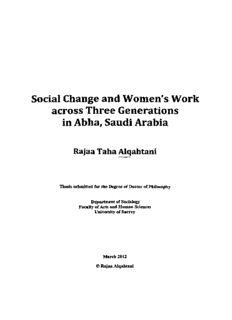
Social Change and Women's Work across Three Generations in Abha, Saudi Arabia PDF
Preview Social Change and Women's Work across Three Generations in Abha, Saudi Arabia
Social Change and Women's Work across Three Generations in Abha, Saudi Arabia Rajaa Taha Alqahtani Thesis submittedfor the Degree ofDoctorofPhilosophy DepartmentofSociology FacultyofArts and Human Sciences UniversityofSurrey March 2012 ©RajaaAlqahtani Abstract Women's work participation in Saudi society has been characterised as low and limitedto a few gender-segregated fields; mainly in education and social services. However, previous social studiesprovide limitedexplanations forthis,andatthe sametimelittle isknownaboutthehistory ofwomen'swork in thepre-Oil era.Today younger generations ofwomenarefacinghighrates of unemployment and underemployment, which requires a deep analysis andunderstanding. Hence, this study aimed to reveal various aspects ofpaid and unpaid work across three generations of womeninAbha startingfromtheestablishment oftheSaudistatein 1932tothepresent day. The study explored the main factors ofsocial change that have constructed women's work, how work experiences have influenced women's lives and identities, and the links between women's work and theirempowerment. To achieve this, the research involved aqualitative studybased on 77 in-depth interviews with women in Abha, southwest Saudi Arabia. A purposive sample of women was collected from three generations of women, which included a range of socio economic classes. Major fmdings of this study indicate that women's position in the labour market has been influenced by a complex ofeconomic and cultural factors, the core ofwhich have been directed by theSaudistate'spoliticalproject ofbeing "modem and Islamic".Arangeofmechanisms have been mobilised, particularly regarding state policies, gender segregation system and education, withprofound implications forwomen'slives.Women havebeen amarkeroftheState'spolitical project, andhaveembodiedtheparadoxical aspects ofthisproject asmodembut Islamic. Although factors ofsocial change and work experience have had different impacts on women belonging to various generations and socio-economic backgrounds, they have moulded the collective identity for Saudi women in Abha, which has transferred from local to national, and finally to a contested national identity. Across the three generations, women's empowermenthas been limited by lack of resources and restricted agency. This makes achieving empowerment through employment by 2015, as required by the Millennium Development Goals (UN 2000), a very difficultgoaltoachieveunlessthe statelaunchesanurgentreformplan. I Statement of Originality This thesis and the work to which it refers are the results ofmy own efforts. Any ideas, data, images ortext resulting from the work ofothers (whetherpublishedorunpublished) are fully identified as such within the work and attributed to their originator in the text, bibliography or in footnotes. This thesis has not been submitted in whole or in part for any other academic degree or professional qualification. I agree that the University has the rightto submitmy worktotheplagiarism detection serviceTurnitinUK fororiginality checks. Whether or not drafts have been so-assessed, the University reserves the right to require an electronic version of the final document (as submitted) for assessment as above. Rajaa TahaAlqahatni 16March 2012 II Acknowledgments Firstand Most ofall, praisebe to Allahfor providingme withstrengthand persistenceto manage all the challengesto complete this study Throughoutthis research, Iwas fortunate to have the supportofmanyexceptional peoplewhich Iwouldlike to acknowledgewithdeep gratitude: Dr. NoraAl-Sa'adwho believedin me and helpedme make this dreamcometrue. My supervisor, Professor.Sara Arberwho providedme with her valuable guidance. My very specialmother, for her devotedsupportall the waythroughthis research, for beingthe first gatekeeperofmy fieldwork, and for beingthe principal carerfor my childrenenablingme to fulfil the dream she instilledin me. My father, myfirst tutor, whose knowledge and wisdom have inspiredme all throughthis research My husbandwhose love and assistancehelpedme throughoutthis study My friend and Ph.D researcherKholoodAsiri for readingand providingmy studywith invaluable commentsand mostofall for herpositive spiritthat alwaysenlightenedme My Cousin, SalmaAl-Qodarri, the main gatekeeperofthe fieldwork, who providedme withenormousguidance and helpedme in accessingthe women's arenain Abha DrNoraAl-Mosaedforkindlyreadingpartsofthisstudyandmakingvaluablesuggestions. Ms. AgnesMcGill,not onlyfor editingmythesisbutmostofall herdevotedsupport. The informantsofthis studywho openedtheirhomes and heartsfor me, and made this studypossible and enjoyable MysponsorKing Abdul Aziz Universityand Saudi Cultural Bureau in UKthat have generouslyfunded this research My siblingsRima, Waleed and Wael; and my friends Huda, Lu, Ahlam, Manal, Sara, Rasha, Samia, Pam; Wafaa and all familymembers and friends for providingme not onlywiththeiremotional supportbuttheirpracticalhelp in caringfor my children, discussingsome ideas and transcribingor computingassistance. The apples ofmy eye, my children, Sakhrand Rajwawho bravelyenduredthe time Iwas busyor away, and have filled my heartwithhappiness. III Dedication To Saudi Women To My Grandmothers, Salha BenMusalat & Abdiyah Ben Aydh, May Allah bless their souls, and Saudi women oftheirgeneration Hopingthis research contributesto documentingaprecious part ofwomen's historyin Saudi Arabia. To MyMother, Zinab Mimish, and her boom generation Hopingthis researchprovides adeeperunderstandingofthe changing periodofwomen's lives inthat era. To My daughter, Rajwa and her generation Hopingthis study will contributeto constructingabetterlife for you and all Saudi people. N Table of Content ABSTRACT STATEMENTOFORIGINALITY II ACKNOWLEDGMENTS III DEDICATION IV TABLEOFCONTENT V LISTOFTABLES VIII LISTOFFIGURES IX 1.INTRODUCTION 1 1.1THESISSTRUCTURE 4 2.ABHAANDSOCIALCHANGE 9 2.1ABHAINTHEWIDERGEOGRAPHICALREGION 9 2.2THEREGIONOF'AsIRTHROUGHDIFFERENTHISTORICALPHASES 10 2.3THECITYOFABHAANDSOCIALSTRATIFICATION 14 2.4THEECONOMYOF'AsIRANDSAUDIARABIA 18 2.5THESAUDIPOPULATIONANDTHELABOURMARKET 24 2.6CONTESTATIONWITHINTHECULTURALSYSTEM: 27 2.7CONCLUSION 33 3.UNDERSTANDINGANDTHEORIZINGTHEEXPERIENCEOFSAUDIWOMEN 34 3.1WOMENWITHINTHEPATRIARCHALORDER 3S 3.2WOMENANDTHESTATE 38 3.3WOMEN,CULTUREANDRELIGION 47 3.4WOMEN'SEMPOWERMENT 53 3.5CONCLUSION 57 4.CONTEXTUALIZINGWOMEN'SWORKINSAUDISOCIETY 60 4.1WOMEN'SUNPAIDWORK 60 4.2WOMEN'SPAIDWORK 64 4.3CONDITIONSOFWOMEN'SWORK 69 4.4CONCLUSION 84 v S.METHODOLOGY 86 5.1AIMSOFTHESTUDY 86 5.2QUALITATIVERESEARCH 87 5.3IN-DEPTHINTERVIEWS 88 5.4RESEARCHDESIGNANDSAMPLING 89 5.5THEPILOTSTUDIESANDTHEMAINSTUDY 96 5.6GAININGACCESSTOWOMEN'SARENAINTHEFIELDWORK 98 5.7CONDUCTINGTHEIN-DEPTHINTERVIEW 102 5.8ETHICSOFTHEQUAlITATIVESTUDY 106 5.9RELIABILITYANDVALIDITY 107 5.10CODINGANDDATAANALYSIS 108 5.11CONCLUSION 111 6. FIRSTGENERATIONWOMENANDUNPAIDWORK 113 6.1.HOUSEHOLDWORK 115 6.2AGRICULTURALWORK 123 6.3DIVISIONOFUNPAIDWORK 130 6.4UNPAIDWORKANDWOMEN'SEMPOWERMENT 140 6.5CONCLUSION 143 7.FIRSTGENERATIONWOMENANDPAIDWORK 146 7.1NATUREOFPAIDWORKANDCLASS 146 7.2GENDERDIVISIONOFPAIDWORK 158 7.3PAIDWORKANDWOMEN'SEMPOWERMENT 160 7.4FIRST-GENERATIONWOMENANDIDENTITY 164 r.s CONCLUSION 167 8.SECONDGENERATIONANDTHESTRUCTUREOFWOMEN'SWORK 170 8.1UNPAIDWORK 170 8.2PAIDWORK 174 8.3GENDEREDSEGREGATIONINTHEBOOMERA 185 8.4CONCLUSION 189 9.SECONDGENERATION,CLASS,IDENTITYANDEMPOWERMENT 190 9.1CLASSANDWOMEN'SWORK 190 9.2PAIDWORKANDWOMEN'SEMPOWERMENT 193 VI 9.3SECOND-GENERATIONWOMENANDIDENTITY 204 9.4CONCLUSION 207 10.THIRDGENERATION,WOMENANDWORK 209 10.1UNPAIDWORK 209 10.2PAIDWORK 211 10.3UNEMPLOYMENT 221 10.4WOMEN'SCLASSANDPAIDWORK 222 10.5GENDERSEGREGATION 225 10.6THIRDGENERATIONANDEMPOWERMENT 227 10.7WOMEN'SWORKANDIDENTITY 234 10.8CONCLUSION 237 11. DISCUSSION:THECONSTRUCTIONOFWOMEN'SWORK 240 11.1THEFORMATIONOFTHEISLAMICPOLITICALPROJECTANDWOMEN'SWORKACROSSTHETHREEGENERATIONS 241 11.2THESTATE'SMECHANISMSFORIMPLEMENTINGTHEMODELOFMUSLIMWOMEN 249 11.3CONCLUSION 258 12.CONCLUSIONS"THECIRCUMSCRIBEDWORKINGWOMEN" 260 12.1DIVERSITYAMONGWOMENANDTHEIRWORKEXPERIENCES 261 12.2CONSTRUCTIONOFNATIONALIDENTITYOFWOMENIN'AsIR 264 12.3WOMEN'SWORKANDEMPOWERMENTACROSSTHREEGENERATIONS 270 12.4WOMEN'SWORKANDACHIEVEMENTOFEMPOWERMENT 278 BIBLIOGRAPHY 283 APPENDIX1(GLOSSARY) 315 APPENDIX2(INTERVIEWGUIDELINE) 321 APPENDIX3(ARABICINTERVIEWGUIDELINE) 324 APPENDIX4MAPOFABHAWITHARABIC 326 VII List ofTables TABLE2.1:THEPOPULATIONGROWTHINSAUDIARABIA 24 TABLE5.1:EXPLANATIONOFTHEINFORMANT'SCODE 94 TABLE5.2:THESAMPLESIZEANDSTRATIFICATIONBYGENERATIONANDSOCIO-ECONOMIC GROUP 95 TABLE6.1:FIRSTGENERATIONWOMENANDTHEIREXPERIENCEOFUNPAIDANDPAIDWORK 114 TABLE7.1:PAIDWORKUNDERTAKENBYFIRSTGENERATIONWOMEN 147 TABLE8.1:SECONDGENERATION,WORKANDEDUCATIONALLEVEL 178 TABLE8.2:EDUCATIONALLEVELANDWORKAMONGSECONDGENERATIONWOMEN 179 TABLE10.1: EDUCATIONANDWORKOFTHIRDGENERATIONWOMEN 212 TABLE10.2: CLASSESANDWORKAMONGTHIRD GENERATIONWOMEN 222 VIII List of Figures FIGURE2.1: MAPOFSAUDIARABIAINCLUDINGTHEREGIONOFASIR 11 FIGURE2.1: THECITYOFABHAINTHE1950 14 FIGURE2.1: MODERNABHA2000 20 FIGURE2.4: mSTORYOFOILPRICE 23 FIGURE2.5: LABOURFORCE,EDUCATIONANDNATIONALITY 26 FIGURE4.1PERCENTAGEDISTRIBUTIONOFEMPLOYEDSAUDISBY EDUCATIONALLEVELANDGENDER 83 FIGURE6.1:AL-MEEFA(THEFIREWOOD-BURNINGSTOVE) 117 FIGURE6.2:QATTPAINTINGININTHEMIDDLEOFTHEWALL 121 FIGURE6.3:MAPOFOLDABHA 125 FIGURE6.4:WOMENCARRYINGBOUNDLESOFFIRE-WOOD 127 FIGURE6.5:MOUNTAINTERRACESIN'ASIR 132 FIGURE7.1:WOMENCARRYING"GERBAH"(WATERGOAT-SKIN)INTHESTREETSOFABHA 149 FIGURE7.2: FEMALEQATTPAINTERRACTICINGQATTFERSCO 151 FIGURE7.3: QATTPAINTINGINA5STARHOTELINABHA 152 FIGURE7.4: FEMALESHOPKEEPERINTUESDAYMARKETINABHA 154 FIGURE10.1MOUNTAINROADS "AL-'AQABBAH"IN'ASIR 215 FIGURE10.2SAUDIFEMALEDOCTORS 216 IX
Description: